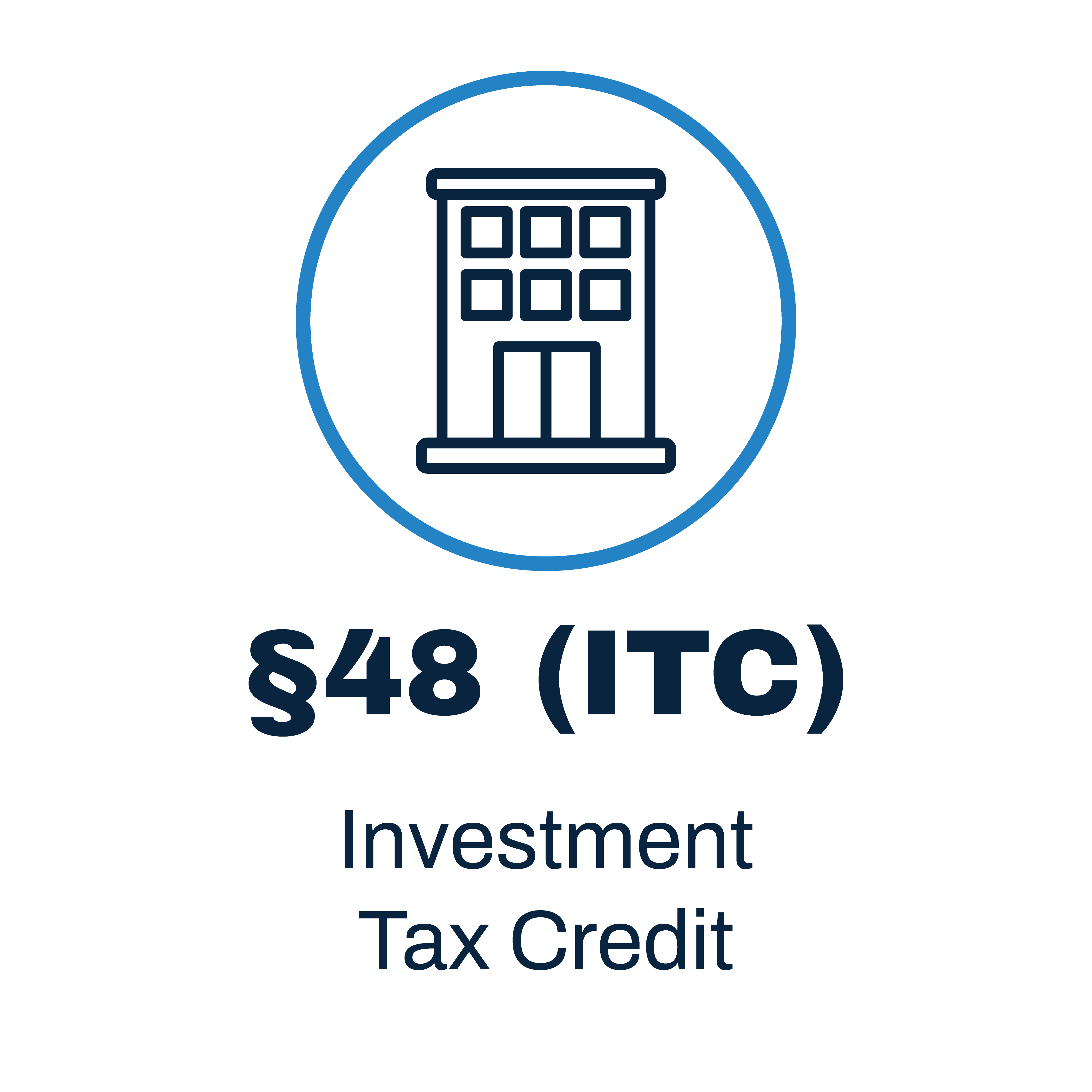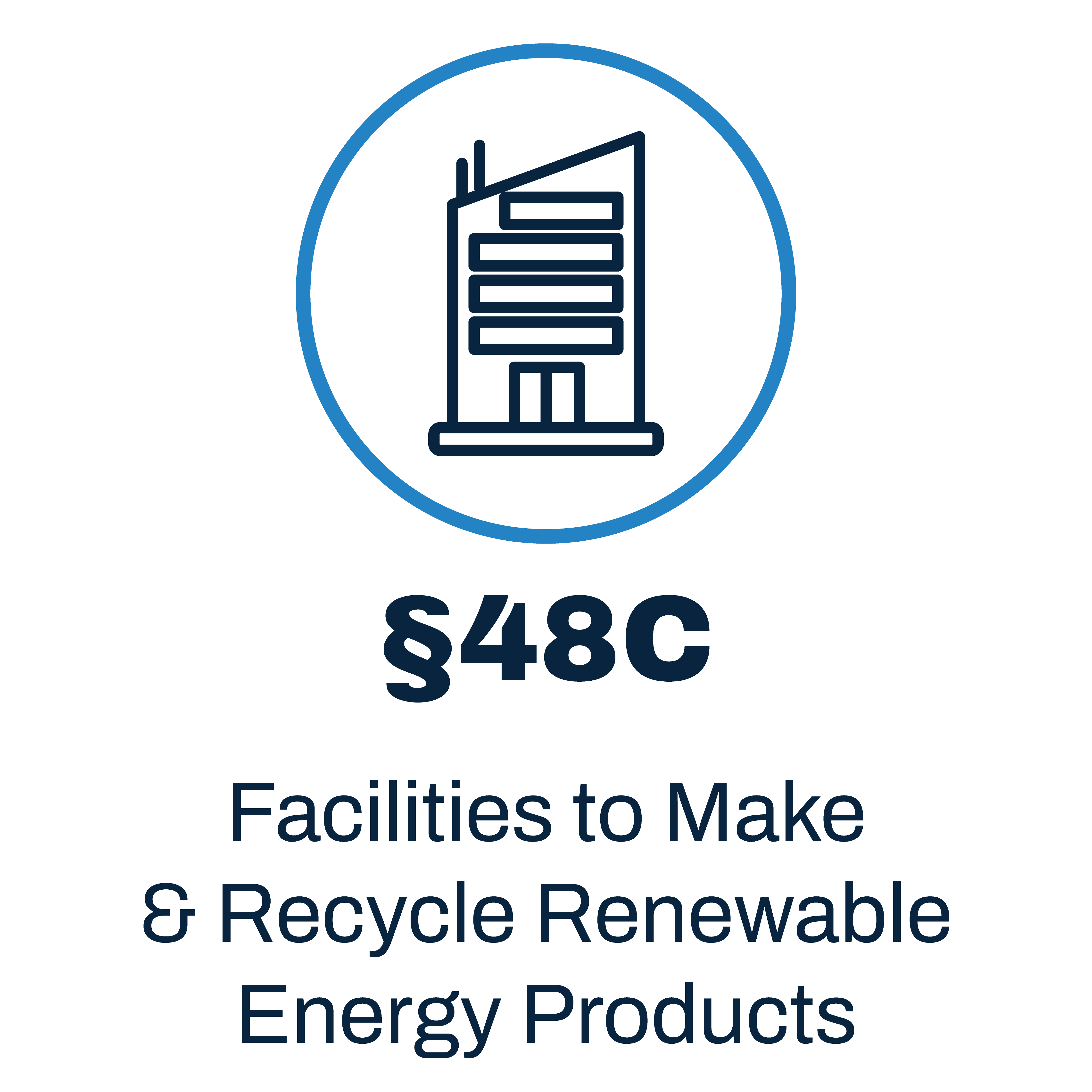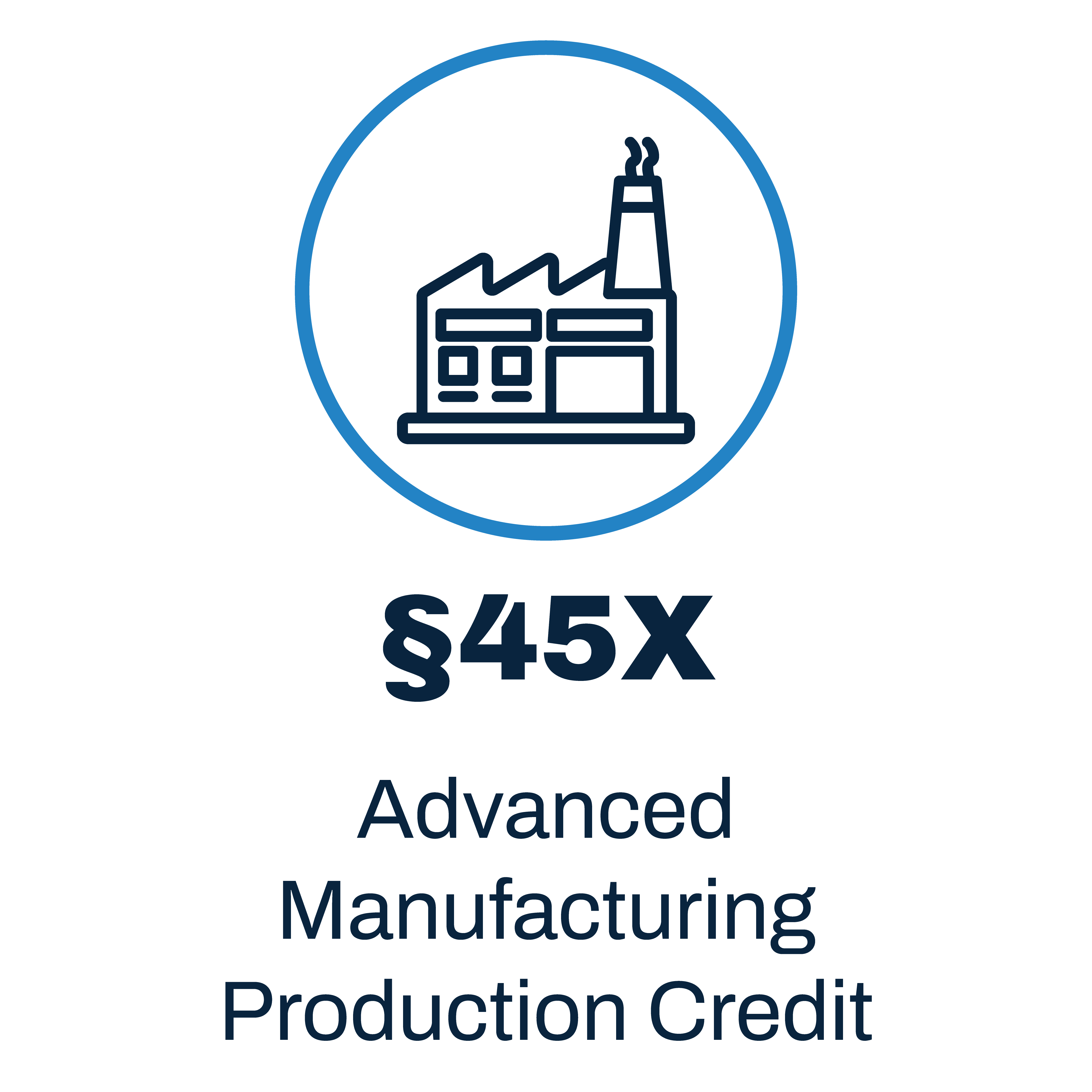Renewable Energy Tax Credits
Talk to a Renewable Energy Tax Credit Specialist Today!
IRC §48C
IF YOU ARE…
- Expanding your plant for manufacturing renewable energy products
- Adding or expanding recycling facilities for renewable energy equipment or critical materials and minerals
- Planning to install equipment in your plant to reduce greenhouse gases
YOU MAY QUALIFY FOR UP TO A 30% FEDERAL TAX CREDIT
Advanced Energy Projects Program
If you answer yes to any of these questions, the Advanced Energy Projects Program can help you!
This program awards allocations through an ongoing application process. Even if you can’t use the credits, they can be sold for cash through the provisions of the Inflation Reduction Act of 2022.
Qualifying Category 1
EXAMPLES
-
Solar, hydro, wind, geothermal, or other renewable energy equipment
-
Fuel cells, microturbines, or energy storage systems
-
Electric grid modernization equipment and components
-
Carbon capture and sequestration equipment, or used for reducing greenhouse gas emissions
-
Equipment for refining or blending renewable fuels
-
Equipment for energy conservation for residential, commercial, or industrial use
-
Energy storage systems for electric or hybrid vehicles
Qualifying Category 2
EXAMPLES
- Low- or zero-carbon process heat systems
- Carbon capture, transport, utilization and storage systems
- Energy efficiency and reduction in waste from industrial processes
- Any other industrial technology designed to reduce greenhouse gas emissions
Qualifying Category 3
CRITICAL MATERIALS
- Including non-fuel minerals, elements, substances, or materials with high risk of supply chain disruption. They serve essential functions in energy technologies that produce, transmit, store, or conserve energy, as well as those using critical minerals like lithium and cobalt.
CRITICAL MINERALS
- Prominent examples of critical minerals include lithium and cobalt. For more information, refer to the Department of the Interior’s 2022 Final List of Critical Minerals.
OR
IRC §48
UPDATES TO IRC §48
The Inflation Reduction Act of 2022 brought the most significant and transformative renewable energy incentive opportunities to help US businesses manage and substantially reduce their energy costs and improve their energy security. Taking the next step toward enhancing our renewable energy infrastructure, it builds on gains from the American Recovery and Reinvestment Act of 2009. Not just limited to big energy, utility companies, and tax equity investors, the benefits of clean energy are available to any business that consumes electricity in its day-to-day operations.
Types of Qualified Energy Property
-
Energy Storage / Batteries placed in service after 2022 (*NEW)
-
Microgrid Controllers placed in service after 2022 (*NEW)
-
Interconnection Property placed in service after 2022 (*NEW)
-
Qualified Biogas Property placed in service after 2022 (*NEW)
-
Qualified Small Wind (less than 5 MW output)
-
Solar (less than 5 MW output)
-
Combined Heat & Power (CHP)
-
Waste Energy Recovery Property
-
Fiber-Optic Solar Lighting
-
Geothermal Heat Pump
-
Geothermal
-
Qualified Microturbine
-
Qualified Fuel Cell
Rates and Operating Rules
- Credits for certain “Energy Projects” can be increased 5x by meeting prevailing wage and apprenticeship rules.
- The Energy Credit can be treated as a tax payment if the taxpayer is a Not-for-Profit entity per §6417
- Credit rates range from 6% – 30% depending on the type, construction start date, and placed-in-service date
- Construction must be completed, or original use of the Property must commence with the taxpayer
- The Energy Credit is a “Specified credit” which can offset AMT per §38(c)(4)(B)(x)
- Property must conform to performance and quality standards
- Requires a §50(c)(3) basis reduction of 50% of the ITC
- The Energy Credit can be transferred per §6418
- Property must be depreciable
OR
IRC §45X
IF YOU ARE…
- Manufacturing certain renewable energy or energy storage products, parts, or components in the US
- Producing critical minerals in the US, including aluminum, beryllium, chromium, cobalt, lithium, and others
- Selling to an unrelated person as a part of your company’s trade or business
YOU MAY QUALIFY FOR A PRODUCTION TAX CREDIT FOR UP TO 10 YEARS THROUGH 2032
Eligible Components
Solar Energy
-
Photovoltaic cells
-
Photovoltaic wafers
-
Polymeric back sheets
-
Solar grade polysilicon
-
Solar modules
-
Solar trackers and components, including torque tubes and structural fasteners
Wind Energy
-
Blades
-
Nacelles
-
Towers
-
Offshore wind foundations
-
Related offshore wind vessels
Inverters (DC TO AC)
-
Central inverters with a capacity greater than 1 MW
-
Commercial inverters suitable for commercial or utility-scale applications
-
Distributed wind inverters with a capacity of up to 150 kilowatts
-
Microinverters with a rated output of 120/240-volt single phase or 208/480 three-phase power
-
Residential inverters with a rated output of 120/240-volt single-phase power
-
Utility inverters with a rated output of not less than 600 volt three-phase power
Batteries
-
Electrodes
-
Battery cells
-
Battery modules
Critical Minerals
-
Minerals that are critical components in the manufacture of certain renewable energy products
-
Aluminum, beryllium, chromium, cobalt, graphite, lithium, nickel, tungsten and others
OR
Ready to find out if you qualify?
Frequently Asked Questions
How do I know if my business can qualify for a Renewable Energy Investment Tax Credit (RE-ITC)?
Virtually any business or facility that uses electricity to generate heat, light, or produce goods or services can take advantage of the RE-ITC which can be up to 30% of your qualified costs for renewable energy property placed in service after January 31, 2021, and where construction begins by December 31, 2024. Discuss with your energy consultants to learn more about your renewable options then we can assist in determining qualification and pro forma estimated benefits for finance and tax planning purposes.
What are “qualified costs” for the RE-ITC, and how do I document them for tax purposes?
Once you have considered your choices, we can review your plans and provide tax guidance by identifying “qualified energy property” for maximizing your RE-ITC. Typically this includes property used in constructing or installing equipment or facilities for renewable energy generation. We can also evaluate related energy components, including newly allowable microgrid connection and battery storage installations, and provide a detailed cost allocation report for filing purposes. Often this is done in conjunction with a cost segregation study which we can also provide and issue a comprehensive report for tax filing. This will be especially important if you choose to sell your RE-ITC’s.
What if I can’t use the RE-ITC against my current tax liability?
You, as the taxpayer, have several options when determining the use of the generated RE-ITC’s. If you are a not-for-profit, an election can be made to treat the RE-ITC as a tax payment, effectively making it a refundable tax credit that you can claim on your annual return. If you are a for-profit business, the RE-ITC can offset AMT, and then to the extent you cannot use the RE-ITC against current tax, it can either be carried back 3 years and forward 22 years or sold on a market exchange. If sold, due diligence will likely need to be performed to assure the value of the credits and to prevent overstatement and the 20% excess claim penalty.
Where can I learn more about options and the best choices for my business?
Our RE-ITC specialists can review the available alternatives with you and your energy team and consult on the qualification rules and best methods to capture costs. We can also prepare calculations and a report to substantiate credits to support tax filings and the due diligence process if you intend to sell your RE-ITC on the transfer market. If you do not have an energy engineer, we work with a number of consultants who would gladly help navigate the complexities and advantages, and disadvantages of various renewable energy types and their requirements.



